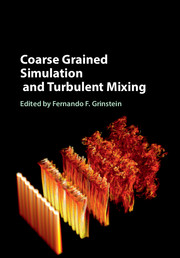36 results
Contributors
-
- Book:
- Coarse Grained Simulation and Turbulent Mixing
- Published online:
- 05 June 2016
- Print publication:
- 30 June 2016, pp ix-x
-
- Chapter
- Export citation
Index
-
- Book:
- Coarse Grained Simulation and Turbulent Mixing
- Published online:
- 05 June 2016
- Print publication:
- 30 June 2016, pp 443-444
-
- Chapter
- Export citation
9 - Laser Driven Turbulence in High Energy Density Physics and Inertial Confinement Fusion Experiments
- from Part III - Complex Mixing Consequences
-
-
- Book:
- Coarse Grained Simulation and Turbulent Mixing
- Published online:
- 05 June 2016
- Print publication:
- 30 June 2016, pp 232-281
-
- Chapter
- Export citation
Preface
-
- Book:
- Coarse Grained Simulation and Turbulent Mixing
- Published online:
- 05 June 2016
- Print publication:
- 30 June 2016, pp xi-xii
-
- Chapter
- Export citation
Prologue
-
-
- Book:
- Coarse Grained Simulation and Turbulent Mixing
- Published online:
- 05 June 2016
- Print publication:
- 30 June 2016, pp 1-12
-
- Chapter
- Export citation
8 - Shock Driven Turbulence
- from Part III - Complex Mixing Consequences
-
-
- Book:
- Coarse Grained Simulation and Turbulent Mixing
- Published online:
- 05 June 2016
- Print publication:
- 30 June 2016, pp 193-231
-
- Chapter
- Export citation
Part III - Complex Mixing Consequences
-
- Book:
- Coarse Grained Simulation and Turbulent Mixing
- Published online:
- 05 June 2016
- Print publication:
- 30 June 2016, pp 191-442
-
- Chapter
- Export citation
Epilogue
- from Part III - Complex Mixing Consequences
-
-
- Book:
- Coarse Grained Simulation and Turbulent Mixing
- Published online:
- 05 June 2016
- Print publication:
- 30 June 2016, pp 432-442
-
- Chapter
- Export citation
Contents
-
- Book:
- Coarse Grained Simulation and Turbulent Mixing
- Published online:
- 05 June 2016
- Print publication:
- 30 June 2016, pp vii-viii
-
- Chapter
- Export citation
Copyright page
-
- Book:
- Coarse Grained Simulation and Turbulent Mixing
- Published online:
- 05 June 2016
- Print publication:
- 30 June 2016, pp iv-iv
-
- Chapter
- Export citation
5 - Subgrid and Supergrid Modeling
- from Part II - Challenges
-
-
- Book:
- Coarse Grained Simulation and Turbulent Mixing
- Published online:
- 05 June 2016
- Print publication:
- 30 June 2016, pp 107-133
-
- Chapter
- Export citation
Part I - Fundamentals
-
- Book:
- Coarse Grained Simulation and Turbulent Mixing
- Published online:
- 05 June 2016
- Print publication:
- 30 June 2016, pp 13-104
-
- Chapter
- Export citation
Part II - Challenges
-
- Book:
- Coarse Grained Simulation and Turbulent Mixing
- Published online:
- 05 June 2016
- Print publication:
- 30 June 2016, pp 105-190
-
- Chapter
- Export citation
Dedication
-
- Book:
- Coarse Grained Simulation and Turbulent Mixing
- Published online:
- 05 June 2016
- Print publication:
- 30 June 2016, pp v-vi
-
- Chapter
- Export citation
1 - Proof of Concept
- from Part I - Fundamentals
-
-
- Book:
- Coarse Grained Simulation and Turbulent Mixing
- Published online:
- 05 June 2016
- Print publication:
- 30 June 2016, pp 15-29
-
- Chapter
- Export citation
Plate section
-
- Book:
- Coarse Grained Simulation and Turbulent Mixing
- Published online:
- 05 June 2016
- Print publication:
- 30 June 2016, pp -
-
- Chapter
- Export citation

Coarse Grained Simulation and Turbulent Mixing
-
- Published online:
- 05 June 2016
- Print publication:
- 30 June 2016
SECTION D - FRONTIER FLOWS
-
- Book:
- Implicit Large Eddy Simulation
- Published online:
- 08 January 2010
- Print publication:
- 30 July 2007, pp 411-412
-
- Chapter
- Export citation
Preface
-
-
- Book:
- Implicit Large Eddy Simulation
- Published online:
- 08 January 2010
- Print publication:
- 30 July 2007, pp vii-viii
-
- Chapter
- Export citation
Index
-
- Book:
- Implicit Large Eddy Simulation
- Published online:
- 08 January 2010
- Print publication:
- 30 July 2007, pp 543-546
-
- Chapter
- Export citation



